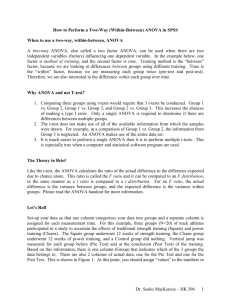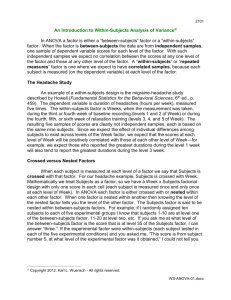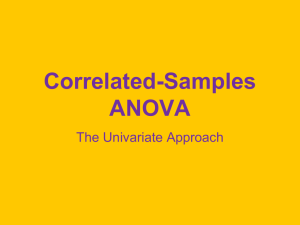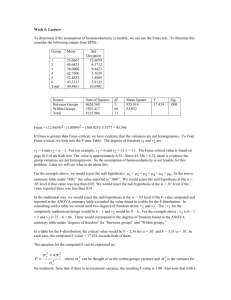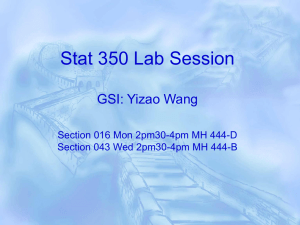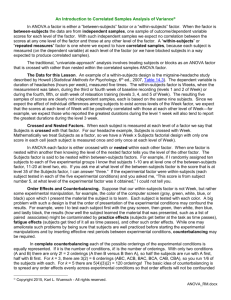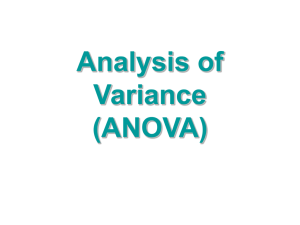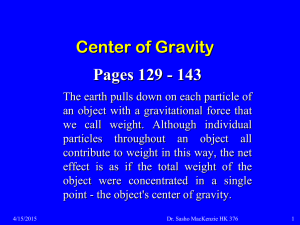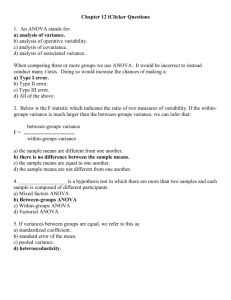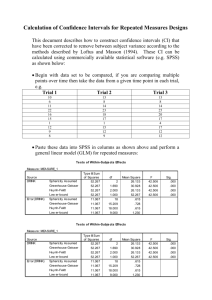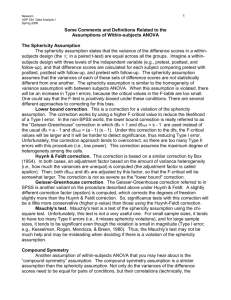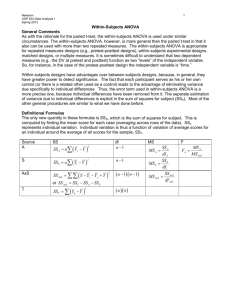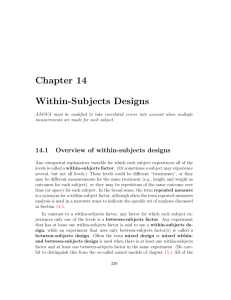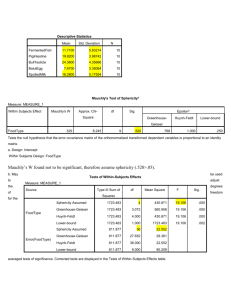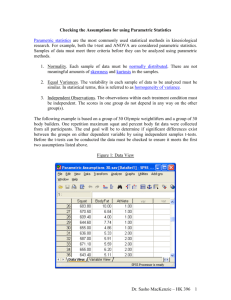How to Perform a Simple Analysis of Variance (ANOVA) in SPSS
advertisement
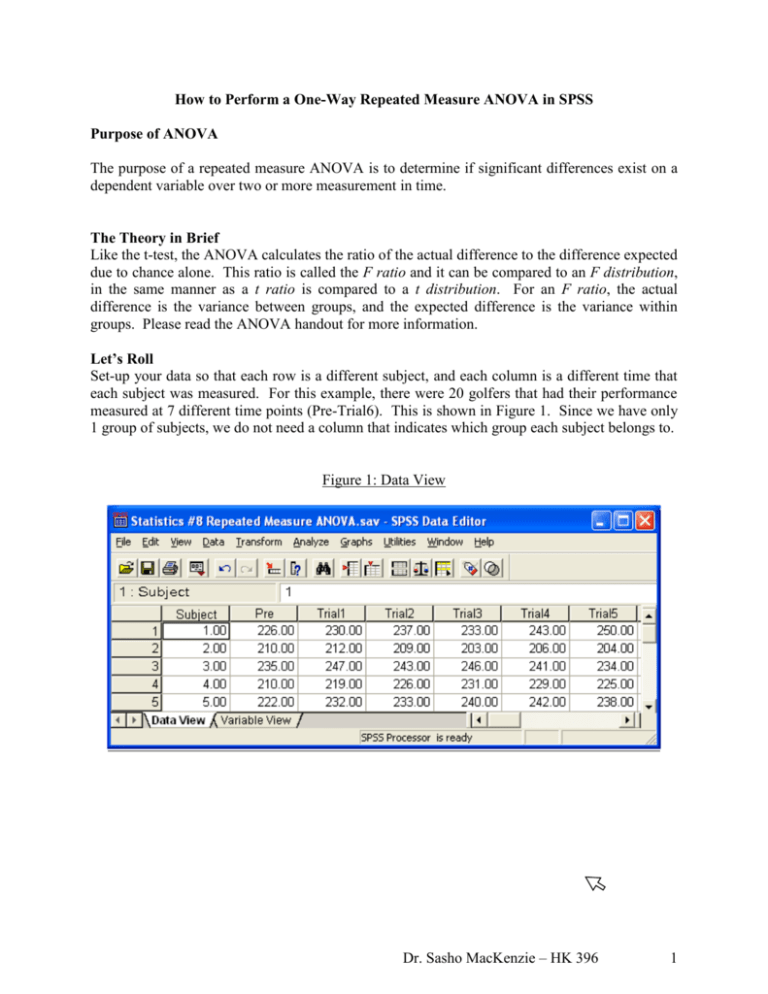
How to Perform a One-Way Repeated Measure ANOVA in SPSS Purpose of ANOVA The purpose of a repeated measure ANOVA is to determine if significant differences exist on a dependent variable over two or more measurement in time. The Theory in Brief Like the t-test, the ANOVA calculates the ratio of the actual difference to the difference expected due to chance alone. This ratio is called the F ratio and it can be compared to an F distribution, in the same manner as a t ratio is compared to a t distribution. For an F ratio, the actual difference is the variance between groups, and the expected difference is the variance within groups. Please read the ANOVA handout for more information. Let’s Roll Set-up your data so that each row is a different subject, and each column is a different time that each subject was measured. For this example, there were 20 golfers that had their performance measured at 7 different time points (Pre-Trial6). This is shown in Figure 1. Since we have only 1 group of subjects, we do not need a column that indicates which group each subject belongs to. Figure 1: Data View Dr. Sasho MacKenzie – HK 396 1 To perform the Repeated Measures ANOVA, select Analyze -> General Linear Model -> Repeated Measures as shown in Figure 2. Figure 2: Starting the Repeated Measures ANOVA Select a name for your within-subject factor. The default is “factor1” but you should change it to something that has relevance. For our example, change it to “trial”. “Levels” is the number of times the measure was repeated. In our example, golf drive performance was measured 7 times. You should then select the “Add” button (See Figure 3). Figure 3: Selecting the Within-Subject Factor Dr. Sasho MacKenzie – HK 396 2 After selecting “Add”, the window should look like Figure 4. At this point you could add another within-subject factor if one existed. “Add” a Measure Name, and hit “Define”. Figure 4: Measure Name After you click “Define”, the window shown in Figure 5 should appear. For a 1 Way Repeated Measure ANOVA, the purpose of this window is to assign each level of the within-subjects variable to the appropriated column of data. As shown below, the columns Pre, Trial1, and Trial2 have been assigned. For this example, there are no between-subjects factors. Dr. Sasho MacKenzie – HK 396 3 Figure 5: The Repeated Measures Window After assigning each level of the within-subjects variable to a column of data, select the “Contrasts” button and the Window shown in Figure 6 will appear. Assume that we are interested in determining if a trial differs significantly from the trial immediately before or the trial immediately after it. Therefore we would like to conduct a “Repeated” measures contrast. If it does not say “trials(Repeated)” in the “Factors:” window, then scroll down to find “Repeated”, and select change. Then hit “Continue”. When we have a variable that increases in an orderly fashion, such as time, what is most important is the pattern of the means. We are much more likely to want to be able to make statements of the form "The effect of this drug increases linearly with dose, " or "This drug is more effective as we increase the dosage up to some point, and then higher doses are either no more effective, or even less effective." We are less likely to want to be so specific as to say "The 1 cc dose is less effective that the 2 cc dose, and the 2 cc dose is less effective than the 3 cc dose. Graduate students often ask me how they can test an effect such as "Time 2 versus Time 4," and I generally tell them that such a question is not particularly meaningful when the repeated measure is ordinal. What is probably happening, and what our eyes say is happening, is that for the Near condition stress levels are increasing, up to a point, and it is probably of very little interest exactly which levels are different from which other levels. That is primarily a question of power, and the answer will vary with the sample size. What is important is that there is some general linear increase, and it is that on which we will focus. To take a homey example, we all know that children tend to grow taller as they age. Do you really want a statistical test of whether 9 years olds are taller than 8.75 year Dr. Sasho MacKenzie – HK 396 4 olds? Statistical significance for such a difference is rarely the point. (Such a test is possible--see the section on non-ordinal levels--but I just don't think it is usually meaningful.) Figure 6: Repeated Measures Contrast Window From the “Repeated Measures” window, select “Plots” and Figure 7 should appear. Select “trial” and place it in the “Horizontal Axis” box. Following this, the “Add” button will become selectable. Select “Add” to bring “trials” into the “Plots:” box at the bottom of the window. Then hit “Continue”. Figure 7: Plots Window Dr. Sasho MacKenzie – HK 396 5 From the “Repeated Measures” window, select “Options” and Figure 8 should appear. Check off “Descriptive statistics” and “Estimates of effect size”. Then hit “Continue”. Figure 8: Options Window From the “Repeated Measures” window, select “OK” to run the 1 Way Repeated Measures ANOVA. The following should help you analyze your data. The first important, and non-obvious, chart in the SPSS output is the test for sphericity. A repeated measures ANOVA must meet the assumption of sphericity. Sphericity requires that the repeated measures demonstrate homogeneity of variance (each group of data has similar variance) and homogeneity of covariance (the correlation of each repeated measure with the dependent variable is similar). If the test is significant (which is indicated in Figure 9) then a correction must be made before the significance of the ANOVA can be interpreted. Three options for a correction factor are supplied in the last three cells in Figure 9. Each degree of freedom used to calculate the F ratio is multiplied by the correction factor (Figure 10). This does not alter the calculated F ratio, but it does increase the probability of making a Type I error. This is clearly demonstrated by noting the various p-values in Figure 10. In general if the correction factors are < .75, a correction to F critical should be made. Dr. Sasho MacKenzie – HK 396 6 Figure 9: Mauchly’s Test of Spericity b Ma uchly's Test of Spheri city Measure: drive a Epsilon W ithin Subject s Effect Mauchly's W trial .015 Approx . Chi-Square 70.385 df 20 Sig. .000 Greenhous e-Geis ser .415 Huynh-Feldt .483 Lower-bound .167 Tests the null hypothes is that t he error covariance matrix of the orthonormalized transformed dependent variables is proportional to an ident ity matrix. a. May be us ed t o adjust the degrees of freedom for the averaged t ests of s ignificance. Corrected tests are displayed in the Tests of W ithin-Subject s Effect s table. b. Int ercept FigureDesign: 10 displays the main results of the one way repeated measure ANOVA. It answers the W ithin Subject s Design: trial question; does the dependent variable change significantly across the various trials? Since the sphericity test was significant, and the correction factors were below .75 (Figure 9), then we should use the correction. Since all the corrected tests still show p-values < .05, we can say that there are significant differences in the dependent variable across trials. Figure 10: Tests of Within-Subjects Effects Tests of Within-Subjects Effects Measure: drive Source trial Error(trial) Sphericity Assumed Greenhous e-Geisser Huynh-Feldt Lower-bound Sphericity Assumed Greenhous e-Geisser Huynh-Feldt Lower-bound Type III Sum of Squares 830.171 830.171 830.171 830.171 3576.400 3576.400 3576.400 3576.400 df 6 2.492 2.899 1.000 114 47.357 55.074 19.000 Mean Square 138.362 333.071 286.399 830.171 31.372 75.520 64.938 188.232 F 4.410 4.410 4.410 4.410 Sig. .000 .012 .008 .049 Partial Eta Squared .188 .188 .188 .188 Figure 11 shows the results of the actions displayed in Figure 6. This table compares each trial with the adjacent trials. It permits the researcher to determine at which point in time a significant change in the dependent variables occurs. For example, we can see that at the = .05 level, the Pre Trial differs significantly from Trial 1, and Trial 6 differs significantly from Trial 7. With numerous repeated measures, often this is not as important as identifying a “trend” in the data. Dr. Sasho MacKenzie – HK 396 7 Figure 11: Tests of Within-Subjects Contrasts Tests of Within-Subjects Contrasts Measure: drive Source trial Error(trial) trial Level 1 vs. Level 2 Level 2 vs. Level 3 Level 3 vs. Level 4 Level 4 vs. Level 5 Level 5 vs. Level 6 Level 6 vs. Level 7 Level 1 vs. Level 2 Level 2 vs. Level 3 Level 3 vs. Level 4 Level 4 vs. Level 5 Level 5 vs. Level 6 Level 6 vs. Level 7 Type III Sum of Squares 168.200 68.450 51.200 1.800 92.450 312.050 593.800 324.550 438.800 694.200 434.550 568.950 df 1 1 1 1 1 1 19 19 19 19 19 19 Mean Square 168.200 68.450 51.200 1.800 92.450 312.050 31.253 17.082 23.095 36.537 22.871 29.945 F 5.382 4.007 2.217 .049 4.042 10.421 Sig. .032 .060 .153 .827 .059 .004 Partial Eta Squared .221 .174 .104 .003 .175 .354 Figure 12 shows the plot of the mean scores for each trial, which is probably more valuable then any of the above statistics. It clearly displays the trend in the data. Performance improved with the consumption of a few beers, but began to decrease after too many. This is referred to as the “inverted U”. Figure 12: Tests of Within-Subjects Contrasts Estimated Marginal Means of drive Estimated Marginal Means 228 226 224 222 1 2 3 4 5 6 7 trial Dr. Sasho MacKenzie – HK 396 8
